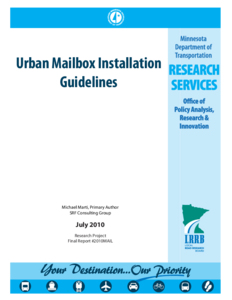System Preservation Guide: A Planning Process for Local Government Management of Transportation Networks (Presentation)
Date Created
2016
Report Number
2016-34PP
Description
Urban Mailbox Installation Guidelines
Creator
Date Created
2010-07
Report Number
2010mail
Description
Traffic Data Collection Improvements
Date Created
2014-02
Report Number
2014RIC51B
Description
Traffic Data Collection Processes Study
Date Created
2014-02
Report Number
2014RIC51A
Description
Sign Retroreflectivity: A Minnesota Toolkit - Updated
Creator
Date Created
2014-09
Report Number
2014RIC22
Description
Gravel Road Management Spreadsheet Tool Supplemental Guidance
Date Created
2019-03
Report Number
2019RIC03
Description
Addressing Citizen Requests for Traffic Safety Concerns
Creator
Date Created
2017
Report Number
2017RIC05
Description






